You can do anything you want with primitive graphic elements. For this reason, I always prefer to design my own plots with just the base R plotting functions, particularly points(), segments(), lines(), abline(), rect(), polygon(), text(), and mtext(). You can easily create curves (e.g. for circles) and more complex shapes using segments() and lines() across granular coordinate vectors that you define yourself. For example, see Plot angle between vectors. This provides much more control over the plot elements you create, however, it often takes more work and careful coding than more prepackaged solutions, so it's a tradeoff.
Data
First, here's your data in runnable form:
df <- data.frame(
sample=c(1,1,1,2,2,2,3,3,3,4,4,4),
mean=c(4.3161,2.3157,1.7446,1949.13,195.07,450.88,2002.98,293.45,681.99,2717.85,432.83,790.97),
part=c('G','F','R','G','F','R','G','F','R','G','F','R'),
sd=c(1.2209,1.7011,1.1618,873.42,47.82,140.31,367.92,59.01,168.03,1106.07,118.02,232.62),
stringsAsFactors=F
);
df;
## sample mean part sd
## 1 1 4.3161 G 1.2209
## 2 1 2.3157 F 1.7011
## 3 1 1.7446 R 1.1618
## 4 2 1949.1300 G 873.4200
## 5 2 195.0700 F 47.8200
## 6 2 450.8800 R 140.3100
## 7 3 2002.9800 G 367.9200
## 8 3 293.4500 F 59.0100
## 9 3 681.9900 R 168.0300
## 10 4 2717.8500 G 1106.0700
## 11 4 432.8300 F 118.0200
## 12 4 790.9700 R 232.6200
OP ggplot
Now, for reference, here's a screenshot of the plot that results from the ggplot code you pasted into your comment:
library(ggplot2);
ggplot(df,aes(x=as.factor(sample),y=mean,fill=part)) +
geom_bar(position=position_dodge(),stat='identity',colour='black') +
geom_errorbar(aes(ymin=mean-sd,ymax=mean+sd),width=.2,position=position_dodge(.9));

Linear Single
Also for reference, here's how you can produce a similar grouped bar plot using base R barplot() and legend(). I've added the error bars with custom calls to segments() and points():
## reshape to wide matrices
dfw <- reshape(df,dir='w',idvar='part',timevar='sample');
dfw.mean <- as.matrix(dfw[grep(perl=T,'^mean\\.',names(dfw))]);
dfw.sd <- as.matrix(dfw[grep(perl=T,'^sd\\.',names(dfw))]);
rownames(dfw.mean) <- rownames(dfw.sd) <- dfw$part;
colnames(dfw.mean) <- colnames(dfw.sd) <- unique(df$sample);
## plot precomputations
ylim <- c(0,4000);
yticks <- seq(ylim[1L],ylim[2L],100);
xcenters <- (col(dfw.sd)-1L)*(nrow(dfw.sd)+1L)+row(dfw.sd)+0.5;
partColors <- c(G='green3',F='indianred1',R='dodgerblue');
errColors <- c(G='darkgreen',F='darkred',R='darkblue');
## plot
par(xaxs='i',yaxs='i');
barplot(dfw.mean,beside=T,col=partColors,ylim=ylim,xlab='sample',ylab='mean',axes=F);
segments(xcenters,dfw.mean-dfw.sd,y1=dfw.mean+dfw.sd,lwd=2,col=errColors);
points(rep(xcenters,2L),c(dfw.mean-dfw.sd,dfw.mean+dfw.sd),pch=19,col=errColors);
axis(1L,par('usr')[1:2],F,pos=0,tck=0);
axis(2L,yticks,las=1L,cex.axis=0.7);
legend(2,3800,dfw$part,partColors,title=expression(bold('part')),cex=0.7,title.adj=0.5[2:1]);

The issue is plain to see. There's nuance to some of the data (the sample 1 means and variability) that is not well represented in the plot.
Logarithmic
There are two standard options for dealing with this problem. One is to use a logarithmic scale. You can do this with the log='y' argument to the barplot() function. It's also good to override the default y-axis tick selection, since the default base R ticks tend to be a little light on density and short on range. (That's actually true in general, for most base R plot types; I make custom calls to axis() for all the plots I produce in this answer.)
## plot precomputations
ylim <- c(0.1,4100); ## lower limit must be > 0 for log plot
yticks <- rep(10^seq(floor(log10(ylim[1L])),ceiling(log10(ylim[2L])),1),each=9L)*1:9;
xcenters <- (col(dfw.sd)-1L)*(nrow(dfw.sd)+1L)+row(dfw.sd)+0.5;
partColors <- c(G='green3',F='indianred1',R='dodgerblue');
errColors <- c(G='darkgreen',F='darkred',R='darkblue');
## plot
par(xaxs='i',yaxs='i');
barplot(log='y',dfw.mean,beside=T,col=partColors,ylim=ylim,xlab='sample',ylab='mean',axes=F);
segments(xcenters,dfw.mean-dfw.sd,y1=dfw.mean+dfw.sd,lwd=2,col=errColors);
points(rep(xcenters,2L),c(dfw.mean-dfw.sd,dfw.mean+dfw.sd),pch=19,col=errColors);
axis(1L,par('usr')[1:2],F,pos=0,tck=0);
axis(2L,yticks,yticks,las=1L,cex.axis=0.6);
legend(2,3000,dfw$part,partColors,title=expression(bold('part')),cex=0.7,title.adj=0.5[2:1]);

Right away we see the issue with sample 1 is fixed. But we've introduced a new issue: we've lost precision in the rest of the data. In other words, the nuance that exists in the rest of the data is less visually pronounced. This is an unavoidable result of the "zoom-out" effect of changing from linear to logarithmic axes. You would incur the same loss of precision if you used a linear plot but with too large a y-axis, which is why it's always expected that axes are fitted as closely as possible to the data. This also serves as an indication that a logarithmic y-axis may not be the correct solution for your data. Logarithmic axes are generally advised when the underlying data reflects logarithmic phenomena; that it ranges over several orders of magnitude. In your data, only sample 1 sits in a different order of magnitude from the remaining data; the rest are concentrated in the same order of magnitude, and are thus not best represented with a logarithmic y-axis.
Linear Multiple
The second option is to create separate plots with completely different y-axis scaling. It should be noted that ggplot faceting is essentially the creation of separate plots. Also, you could create multifigure plots with base R, but I've usually found that that's more trouble than it's worth. It's usually easier to just generate each plot individually, and then lay them out next to each other with publishing or word processing software.
There are different ways of customizing this approach, such as whether you combine the axis labels, where you place the legend, how you size and arrange the different plots relative to each other, etc. Here's one way of doing it:
##--------------------------------------
## plot 1 -- high values
##--------------------------------------
dfw.mean1 <- dfw.mean[,-1L];
dfw.sd1 <- dfw.sd[,-1L];
## plot precomputations
ylim <- c(0,4000);
yticks <- seq(ylim[1L],ylim[2L],100);
xcenters <- (col(dfw.sd1)-1L)*(nrow(dfw.sd1)+1L)+row(dfw.sd1)+0.5;
partColors <- c(G='green3',F='indianred1',R='dodgerblue');
errColors <- c(G='darkgreen',F='darkred',R='darkblue');
par(xaxs='i',yaxs='i');
barplot(dfw.mean1,beside=T,col=partColors,ylim=ylim,xlab='sample',ylab='mean',axes=F);
segments(xcenters,dfw.mean1-dfw.sd1,y1=dfw.mean1+dfw.sd1,lwd=2,col=errColors);
points(rep(xcenters,2L),c(dfw.mean1-dfw.sd1,dfw.mean1+dfw.sd1),pch=19,col=errColors);
axis(1L,par('usr')[1:2],F,pos=0,tck=0);
axis(2L,yticks,las=1L,cex.axis=0.7);
legend(2,3800,dfw$part,partColors,title=expression(bold('part')),cex=0.7,title.adj=0.5[2:1]);
##--------------------------------------
## plot 2 -- low values
##--------------------------------------
dfw.mean2 <- dfw.mean[,1L,drop=F];
dfw.sd2 <- dfw.sd[,1L,drop=F];
## plot precomputations
ylim <- c(0,6);
yticks <- seq(ylim[1L],ylim[2L],0.5);
xcenters <- (col(dfw.sd2)-1L)*(nrow(dfw.sd2)+1L)+row(dfw.sd2)+0.5;
partColors <- c(G='green3',F='indianred1',R='dodgerblue');
errColors <- c(G='darkgreen',F='darkred',R='darkblue');
par(xaxs='i',yaxs='i');
barplot(dfw.mean2,beside=T,col=partColors,ylim=ylim,xlab='sample',ylab='mean',axes=F);
segments(xcenters,dfw.mean2-dfw.sd2,y1=dfw.mean2+dfw.sd2,lwd=2,col=errColors);
points(rep(xcenters,2L),c(dfw.mean2-dfw.sd2,dfw.mean2+dfw.sd2),pch=19,col=errColors);
axis(1L,par('usr')[1:2],F,pos=0,tck=0);
axis(2L,yticks,las=1L,cex.axis=0.7);

This solves both problems (small-value visibility and large-value precision). But it also distorts the relative magnitude of samples 2-4 vs. sample 1. In other words, the sample 1 data has been "scaled up" relative to samples 2-4, and the reader must make a conscious effort to read the axes and digest the differing scales in order to properly understand the plots.
The lesson here is that there's no perfect solution. Every approach has its own pros and cons, its own tradeoffs.
Gapped
In your question, you indicate you want to add a gap across the y range 10:200. On the surface, this sounds like a reasonable solution for raising the visibility of the sample 1 data. However, the magnitude of that 190 unit range is dwarfed by the range of the remainder of the plot, so it ends up having a negligible effect on sample 1 visibility.
In order to demonstrate this I'm going to use some code I've written which can be used to transform input coordinates to a new data domain which allows for inconsistent scaling of different segments of the axis. Theoretically you could use it for both x and y axes, but I've only ever used it for the y-axis.
A few warnings: This introduces some significant complexity, and decouples the graphics engine's idea of the y-axis scale from the real data. More specifically, it maps all coordinates to the range [0,1] based on their cumulative position within the sequence of segments.
At this point, I'm also going to abandon barplot() in favor of drawing the bars manually, using calls to rect(). Technically, it would be possible to use barplot() with my segmentation code, but as I said earlier, I prefer to design my own plots from scratch with primitive graphic elements. This also allows for more precise control over all aspects of the plot.
Here's the code and plot, I'll attempt to give a better explanation of it afterward:
dataCoordToPlot <- function(data,seg) {
## data -- double vector of data-world coordinates.
## seg -- list of two components: (1) mark, giving the boundaries between all segments, and (2) scale, giving the relative scale of each segment. Thus, scale must be one element shorter than mark.
data <- as.double(data);
seg <- as.list(seg);
seg$mark <- as.double(seg$mark);
seg$scale <- as.double(seg$scale);
if (length(seg$scale) != length(seg$mark)-1L) stop('seg$scale must be one element shorter than seg$mark.');
scaleNorm <- seg$scale/sum(seg$scale);
cumScale <- c(0,cumsum(scaleNorm));
int <- findInterval(data,seg$mark,rightmost.closed=T);
int[int%in%c(0L,length(seg$mark))] <- NA; ## handle values outside outer segments; will propagate NA to returned vector
(data - seg$mark[int])/(seg$mark[int+1L] - seg$mark[int])*scaleNorm[int] + cumScale[int];
}; ## end dataCoordToPlot()
## y dimension segmentation
ymax <- 4000;
yseg <- list();
yseg$mark <- c(0,10,140,ymax);
yseg$scale <- diff(yseg$mark);
yseg$scale[2L] <- 30;
yseg$jump <- c(F,T,F);
## plot precomputations
xcenters <- seq(0.5,len=length(unique(df$sample)));
xlim <- range(xcenters)+c(-0.5,0.5);
ylim <- range(yseg$mark);
yinc <- 100;
yticks.inc <- seq(ylim[1L],ylim[2L],yinc);
yticks.inc <- yticks.inc[!yseg$jump[findInterval(yticks.inc,yseg$mark,rightmost.closed=T)]];
yticks.jump <- setdiff(yseg$mark,yticks.inc);
yticks.all <- sort(c(yticks.inc,yticks.jump));
## plot
## define as reusable function for subsequent examples
custom.barplot <- function() {
par(xaxs='i',yaxs='i');
plot(NA,xlim=xlim,ylim=dataCoordToPlot(ylim,yseg),axes=F,ann=F);
abline(h=dataCoordToPlot(yticks.all,yseg),col='lightgrey');
axis(1L,seq(xlim[1L],xlim[2L]),NA,tck=0);
axis(1L,xcenters,unique(df$sample));
axis(2L,dataCoordToPlot(yticks.inc,yseg),yticks.inc,las=1,cex.axis=0.7);
axis(2L,dataCoordToPlot(yticks.jump,yseg),yticks.jump,las=1,tck=-0.008,hadj=0.1,cex.axis=0.5);
mtext('sample',1L,2L);
mtext('mean',2L,3L);
xgroupRatio <- 0.8;
xbarRatio <- 0.9;
partColors <- c(G='green3',F='indianred1',R='dodgerblue');
partsCanon <- unique(df$part);
errColors <- c(G='darkgreen',F='darkred',R='darkblue');
for (sampleIndex in seq_along(unique(df$sample))) {
xc <- xcenters[sampleIndex];
sample <- unique(df$sample)[sampleIndex];
dfs <- df[df$sample==sample,];
parts <- unique(dfs$part);
parts <- parts[order(match(parts,partsCanon))];
barWidth <- xgroupRatio*xbarRatio/length(parts);
gapWidth <- xgroupRatio*(1-xbarRatio)/(length(parts)-1L);
xstarts <- xc - xgroupRatio/2 + (match(dfs$part,parts)-1L)*(barWidth+gapWidth);
rect(xstarts,0,xstarts+barWidth,dataCoordToPlot(dfs$mean,yseg),col=partColors[dfs$part]);
barCenters <- xstarts+barWidth/2;
segments(barCenters,dataCoordToPlot(dfs$mean + dfs$sd,yseg),y1=dataCoordToPlot(dfs$mean - dfs$sd,yseg),lwd=2,col=errColors);
points(rep(barCenters,2L),dataCoordToPlot(c(dfs$mean-dfs$sd,dfs$mean+dfs$sd),yseg),pch=19,col=errColors);
}; ## end for
## draw zig-zag cutaway graphic in jump segments
zigCount <- 30L;
jumpIndexes <- which(yseg$jump);
for (jumpIndex in jumpIndexes) {
if (yseg$scale[jumpIndex] == 0) next;
jumpStart <- yseg$mark[jumpIndex];
jumpEnd <- yseg$mark[jumpIndex+1L];
lines(seq(xlim[1L],xlim[2L],len=zigCount*2L+1L),dataCoordToPlot(c(rep(c(jumpStart,jumpEnd),zigCount),jumpStart),yseg));
}; ## end for
legend(0.2,dataCoordToPlot(3800,yseg),partsCanon,partColors,title=expression(bold('part')),cex=0.7,title.adj=c(NA,0.5));
}; ## end custom.barplot()
custom.barplot();

The key function is dataCoordToPlot(). That stands for "data coordinates to plot coordinates", where "plot coordinates" refers to the [0,1] normalized domain.
The seg argument defines the segmentation of the axis and the scaling of each segment. Its mark component specifies the boundaries of each segment, and its scale component gives the scale factor for each segment. n segments must have n+1 boundaries to fully define where each segment begins and ends, thus mark must be one element longer than scale.
Before being used, the scale vector is normalized within the function to sum to 1, so the absolute magnitudes of the scale values don't matter; it's their relative values that matter.
The algorithm is to find each coordinate's containing segment, find the accumulative distance within the segment reached by the coordinate accounting for the segment's relative scale, and then add to that the cumulative distance reached by all prior segments.
Using this design, it is possible to take any range of coordinates along the axis dimension and scale them up or down relative to the other segments. An instantaneous gap across a range could be achieved with a scale of zero. Alternatively, you can simply scale down the range so that it has some thickness, but contributes little to the progression of the dimension. In the above plot, I use the latter for the gap, mainly so that I can use the small thickness to add a zigzag aesthetic which visually indicates the presence of the gap.
Also, I should note that I used 10:140 instead of 10:200 for the gap. This is because the sample 2 F part error bar extends down to 147.25 (195.07 - 47.82). The difference is negligible.
As you can see, the result looks basically identical to the Linear Single plot. The gap is not significant enough to raise the visibility of the sample 1 data.
Distorted with Gap
Just to throw some more possibilities into mix, now venturing into very non-standard and probably questionable waters, we can use the segmentation transformation to scale up the sample 1 order of magnitude, thereby making it much more visible while still remaining within the single plot, directly alongside samples 2-4.
For this example, I preserve the gap from 10:140 so you can see how it looks when not lying prostrate near the baseline.
## y dimension segmentation
ymax <- 4000;
yseg <- list();
yseg$mark <- c(0,10,140,ymax);
yseg$scale <- c(24,1,75);
yseg$jump <- c(F,T,F);
## plot precomputations
xcenters <- seq(0.5,len=length(unique(df$sample)));
xlim <- range(xcenters)+c(-0.5,0.5);
ylim <- range(yseg$mark);
yinc1 <- 1;
yinc2 <- 100;
yticks.inc1 <- seq(ceiling(yseg$mark[1L]/yinc1)*yinc1,yseg$mark[2L],yinc1);
yticks.inc2 <- seq(ceiling(yseg$mark[3L]/yinc2)*yinc2,yseg$mark[4L],yinc2);
yticks.inc <- c(yticks.inc1,yticks.inc2);
yticks.jump <- setdiff(yseg$mark,yticks.inc);
yticks.all <- sort(c(yticks.inc,yticks.jump));
## plot
custom.barplot();

Distorted without Gap
Finally, just to clarify that gaps are not necessary for inconsistent scaling between segments, here's the same plot but without the gap:
## y dimension segmentation
ymax <- 4000;
yseg <- list();
yseg$mark <- c(0,10,ymax);
yseg$scale <- c(25,75);
yseg$jump <- c(F,F);
## plot precomputations
xcenters <- seq(0.5,len=length(unique(df$sample)));
xlim <- range(xcenters)+c(-0.5,0.5);
ylim <- range(yseg$mark);
yinc1 <- 1;
yinc2 <- 100;
yticks.inc1 <- seq(ceiling(yseg$mark[1L]/yinc1)*yinc1,yseg$mark[2L],yinc1);
yticks.inc2 <- seq(ceiling(yseg$mark[2L]/yinc2)*yinc2,yseg$mark[3L],yinc2);
yticks.inc <- c(yticks.inc1,yticks.inc2);
yticks.jump <- setdiff(yseg$mark,yticks.inc);
yticks.all <- sort(c(yticks.inc,yticks.jump));
## plot
custom.barplot();

In principle, there's really no difference between the Linear Multiple solution and the Distorted solutions. Both involve visual distortion of competing orders of magnitude. Linear Multiple simply separates the different orders of magnitude into separate plots, while the Distorted solutions combine them into the same plot.
Probably the best argument in favor of using Linear Multiple is that if you use Distorted you'll probably be crucified by a large mob of data scientists, since that is a very non-standard way of plotting data. On the other hand, one could argue that the Distorted approach is more concise and helps to represent the relative positions of each data point along the number line. The choice is yours.






